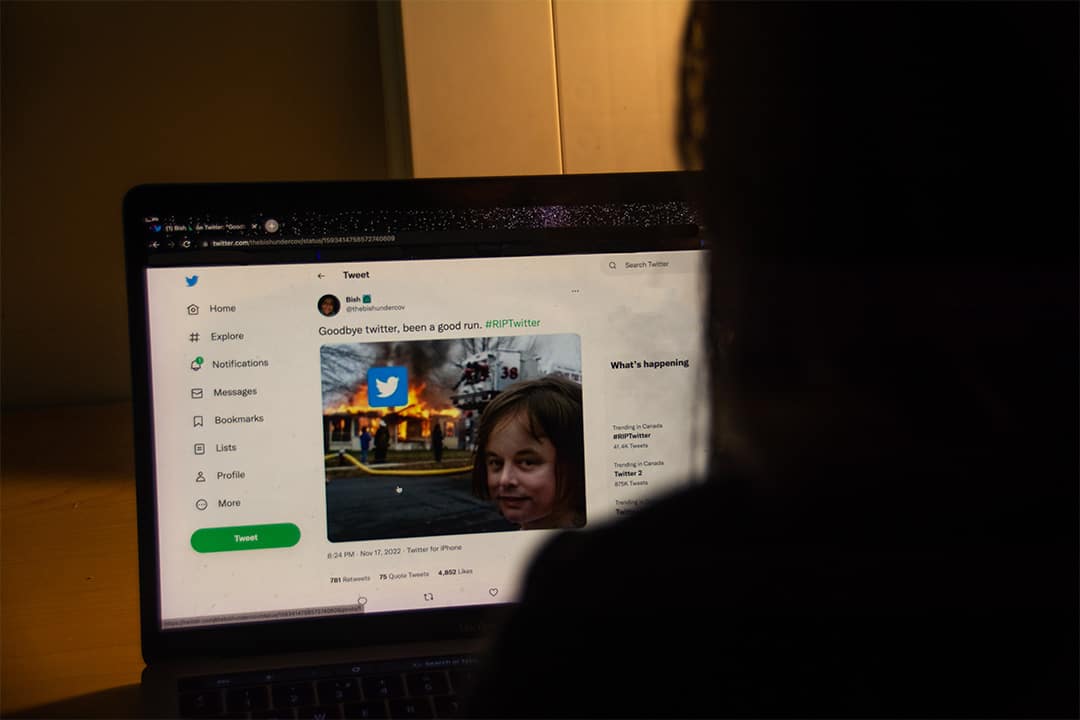Scrolling through Twitter has a brand-new feel to it. What once felt to me like a flawed but relatively well managed environment has now become a landscape primarily shaped by misinformation. Why? Well, it seems that new ideas emerging from the mind of Twitter’s new owner, Elon Musk, have led to an atmosphere that feels polluted.
As a platform, Twitter has traditionally had a pretty humble goal: helping people stay connected through short posts known as tweets. And yet, Musk’s acquisition — a surprising power move brought on by a simple joke — has thrown all of that out the window. Now, the joke has become reality and resulted in major changes in the way the platform operates. More specifically, the arrival of a short-lived paid subscription service, which has provoked a flurry of fake accounts, raises a question: is Twitter on its last legs?
Breaking trust
The major change, of course, is that content moderation is much less strict in the name of free speech. This is so much the case that for a brief period of time, users were able to acquire verification status — a blue checkmark, formerly reserved for accounts Twitter had verified as real notable people, celebrities, or organizations — through a monthly subscription service known as Twitter Blue.
Predictably, Twitter Blue resulted in a rampant uprising of people impersonating celebrities and major organizations, meaning that all sources had to be looked at more critically, with the risk of otherwise consuming something insincere.
Musk essentially created a new form of fake news carried by the mouthpiece of seemingly real celebrities, politicians, and organizations. There was a new surge in misinformation, written off as jokes by impersonators, that still inevitably had consequences.
A fake account was made for Premier Doug Ford that poked fun at him, but it could easily be construed as offensive and have real political consequences if a user were to think it was his actual account. One Tweet from the fake account stated, “If you’ve got a sick kid, I want you to know that I do not want them anywhere near my cottage.”
Another fake account impersonated Eli Lilly & Co. and tweeted “insulin is free now.” The real company’s total stock value then dropped by $15 billion, leading it to halt its advertising deal with Twitter. Fake accounts have broken celebrities’ and companies’ trust in the platform, if not the whole internet’s. And yet, Twitter’s biggest victim may be itself.
But what about Twitter?
Musk’s approach to content moderation has, ironically, led to his own platform being used against him. The #StopToxicTwitter coalition — dedicated to boycotting the platform and convincing advertisers to do the same — has attempted to pressure Musk into bringing back content moderation amidst concerns over brand safety and a major influx of misinformation that is turning Twitter into a dangerous landscape.
The fake accounts have even targeted Musk himself. A parody Tesla account tweeted, “We will be offering 10,000 vehicles to support the Ukrainian military,” and that’s not to mention all the accounts impersonating Musk’s personal account.
The sheer amount of backlash and rise of fake accounts forced Musk to remove the subscription service entirely within days of its launch. Simply sweeping the havoc that these fake Twitter accounts had wrought under the rug wouldn’t help Musk reverse or move past the consequences of such a catastrophic move. While presently, it is unclear what exactly Twitter will look like in coming months, we can only imagine what is up next.
It begs the question of why Musk would launch an idea like this in the first place? Why implement something that could clearly be abused? I believe it’s because Musk has no idea what he’s doing.
His entire purchase of Twitter has literally been a big joke from the start, and only now are people starting to realize that it’s not funny anymore. The constant changes and promises for something better are simply ideas with no thought to their consequences. Musk is not qualified to manage this social media giant, which is clear given that he recently issued his employees an ultimatum.
In an email, Musk gave his employees a choice: either accept “extremely hardcore” work or a layoff with three months of severance pay. It’s a simple get-on-board-or-get-out-of-the-way model that, in the coming days, will completely reshape Twitter, just like his other massive layoffs did.
Of course, the memes are still free flowing, and they’ve proved a decent mechanism for exposing the major problems in Musk’s plans. The old saying “if it ain’t broke, don’t fix it” still holds up. Musk didn’t really need to change Twitter at all — the platform was doing fine before he started making wild changes.
As it stands, I do see Twitter’s downfall incoming. Musk’s decisions have irreversibly polluted the platform. While clear efforts have been made to mitigate these consequences through the removal of Twitter Blue, it still remains unclear of what the future holds, especially with a mass layoff still in sight. If Musk really wants to save Twitter, he must do better, before he clips the bird’s wings for good.


